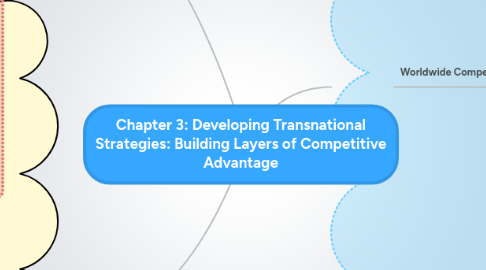
1. Strategies
1.1. International Strategy
1.1.1. Strength
1.1.1.1. Ability to create and leverage information
1.1.2. Weakness
1.1.2.1. deficiencies of efficiency and flexibility
1.2. Multinational Strategy
1.2.1. Companies focus on increasing revenue
1.2.2. Country specific innovations
1.2.2.1. Requires each subsidiary to use own resources for identifying and responding to specific trends
1.2.3. Inability to exploit knowledge and competencies of other units
1.3. Global Strategy
1.3.1. Global efficiency in cost and quality
1.3.2. Compromises flexibility and learning
1.3.3. Inability to capture developments outside of home market
1.4. Transnational Strategy
1.4.1. All three traditional strategies are important and should be combined
1.4.2. Needs sophisticated and differentiated configuration of assets and capabilities
1.4.2.1. Decide which assets and capabilities stay at home
1.4.2.2. Decide which assets and capabilities need not stay at home - try to keep them centralized
1.4.2.2.1. Decentralization
1.4.2.3. Other resources might have to be decentralized on a local basis
2. Strategic Tasks
2.1. DEFENDING WORLD DOMINANCE (muhaha)
2.1.1. Companies that had dominance by perfectioning one of the old traditional strategies got increased competition from more transnational firms
2.1.1.1. Tried to reorganize their assets to become more transnational themselves but had issues with their own structure and governments
2.1.2. Follow two principles
2.1.2.1. Concentrate at least as much on defending and reinforcing your existing assets and capabilities as on developing new ones
2.1.2.2. Imitate the asset structure and task configuration of competitors instead of just trying to match their source of advantage with what you currently have
2.2. Challenging the Global Leader
2.2.1. 1. Find and exploit a niche
2.2.2. 2. Expand your position on both product and geographic dimensions
2.2.2.1. Improve cost and quality step-by-step
2.2.2.2. Focus on products and markets not in the focus of market leader
2.2.2.3. Build manufacturing volume
2.2.3. 3. Become Original Equipment Manufacturer (OEM) manufacturer for competition
2.2.4. 4. Move rapidly to convert niche position into global business or use acquisitions
2.3. Protecting Domestic Niches
2.3.1. Three approaches
2.3.1.1. 1. Defend against competitor's global advantage
2.3.1.1.1. Tie up distribution channels or change market
2.3.1.2. 2. Offset competitor's global advantage
2.3.1.2.1. Lobby for government help
2.3.1.2.2. Become "national champion"
2.3.1.3. 3. Approximate global competitor's advantage
2.3.1.3.1. Form alliance with viable global company
3. Worldwide Competitive Advantage
3.1. Goals:
3.1.1. Global efficiency
3.1.1.1. Efficiency is both cost reduction and revenue enhancement
3.1.1.2. Global Integration - National Responsiveness Framework
3.1.1.2.1. Vertical Axis
3.1.1.2.2. Horizontal Axis
3.1.2. Multinational Flexibility
3.1.2.1. Manage Risk and Exploit opportunities from diversity and volatility in global environment
3.1.2.2. Sources of Diversity and Volatility
3.1.2.2.1. Macroeconomic Risks
3.1.2.2.2. Political Risks
3.1.2.2.3. Competitive Risks
3.1.2.2.4. Resource Risk
3.1.3. Worldwide Learning
3.1.3.1. Key asset of MNEs is diversity of environments in which it operates
3.2. Means:
3.2.1. Scale Economies
3.2.1.1. Experience / Learning Effect
3.2.1.1.1. more production = more opportunity for learning
3.2.2. National Differences
3.2.2.1. Inputs
3.2.2.1.1. Different nations have different factor levels
3.2.2.1.2. Different functions of MNE have different factor requirements
3.2.2.2. Outputs
3.2.2.2.1. Countries have different customer tastes and preferences
3.2.2.2.2. Exploit by reshuffling business models
3.2.3. Scope Economies
3.2.3.1. Diversified firm can share investments and costs across value chains

